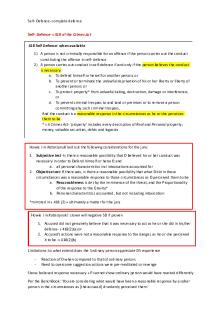Summary Defence power PDF

| Title | Summary Defence power |
|---|---|
| Author | Mikaela Smith |
| Course | Australian Constitutional Law |
| Institution | University of Technology Sydney |
| Pages | 2 |
| File Size | 62.7 KB |
| File Type | |
| Total Downloads | 18 |
| Total Views | 136 |
Summary
Defence power summary...
Description
SUMMARY DEFENCE POWER
1. The scope of the defence power “waxes and wanes”: The scope of the defence power is broad during war time and narrow during peace time. This means that the defence power will support certain laws during war time that it may not support during peace time (see, for example, Andrews v Howell, Stenhouse v Coleman and The Communist Party Case). 2. A law will be characterised as a law with respect to the defence of the Commonwealth where “defence or war is the purpose to which the legislation is addressed” (see Stenhouse v Coleman): This does not permit the courts to investigate the motives of the legislature. Rather, it requires that the purpose be “collected from the [law] in question, the facts to which it applies and the circumstances which called it forth” (see Stenhouse v Coleman at 471 (Dixon J)). 3. In determining whether a particular Commonwealth law could contribute to the defence of the Commonwealth, the courts will show significant deference to the Parliament’s judgment, at least where the issue is raised in the context of active hostilities. See for example, Andrews v Howell and Stenhouse v Coleman but note the Communist Party Case where the majority judges strongly asserted the capacity of the Court to review the Parliament’s claim of the defence necessity of a law. 4. The law must be proportionate to the purpose of defence. The test is whether the law “could reasonably be regarded as a means towards attaining an object which is connected with defence” (see, for example, the Capital Issues Case at 256 (Fullagar J); see also The Communist Party Case (Dixon J) and Thomas v Mowbray).
5. The defence power supports laws which have, as their direct and immediate object, the naval and military defence of the Commonwealth and the States. These include laws that: a. establish the military, the army and the airforce b. establish a system of military discipline c.
concern the enlistment (compulsory or voluntary), and training and equipment, of men and women in navy, army and air force
d. provide for ships and munitions e. provide for the manufacture of weapons, and
f.
build fortifications.
Some judges suggest that these kinds of laws come within the first aspect of defence power (see, for example, Fullagar J in the Communist Party Case).
6. The defence power supports laws that have the purpose of: a. repairing economic damage or strengthening the nation’s economy to enable it to withstand the impact of war (see Andrews v Howell) b. addressing external threats from nation state in a time of war (see, for example, the Communist Party Case) c.
penalising a person or body engaged, or likely to become engaged, in activities prejudicial to defence (see, for example, the Communist Party Case (Fullagar J))
d. protecting the Commonwealth from external enemies (see, for example, the Communist Party Case and Thomas v Mowbray) e. protecting the Commonwealth or the states as polities (see, for example, Thomas v Mowbray), and f.
protecting people and property from a terrorist attack committed inside Australia, regardless of whether the perpetrator is an individual, a group or a foreign State (see Thomas v Mowbray).
Some judges suggest that these kinds of laws come within the second aspect of defence power (see, for example, Fullagar J in the Communist Party Case)....
Similar Free PDFs

Summary Defence power
- 2 Pages

Implied Incidental power summary
- 1 Pages

Race power summary
- 2 Pages

Nationhood power summary
- 2 Pages

Power Summary notes
- 7 Pages

External affairs power summary
- 2 Pages

Defence: Accident
- 4 Pages

Defence - Automatism
- 2 Pages

The Power of Habit Summary
- 18 Pages

The Power Elite Brief Summary
- 2 Pages

Self Defence Legal Framework
- 1 Pages
Popular Institutions
- Tinajero National High School - Annex
- Politeknik Caltex Riau
- Yokohama City University
- SGT University
- University of Al-Qadisiyah
- Divine Word College of Vigan
- Techniek College Rotterdam
- Universidade de Santiago
- Universiti Teknologi MARA Cawangan Johor Kampus Pasir Gudang
- Poltekkes Kemenkes Yogyakarta
- Baguio City National High School
- Colegio san marcos
- preparatoria uno
- Centro de Bachillerato Tecnológico Industrial y de Servicios No. 107
- Dalian Maritime University
- Quang Trung Secondary School
- Colegio Tecnológico en Informática
- Corporación Regional de Educación Superior
- Grupo CEDVA
- Dar Al Uloom University
- Centro de Estudios Preuniversitarios de la Universidad Nacional de Ingeniería
- 上智大学
- Aakash International School, Nuna Majara
- San Felipe Neri Catholic School
- Kang Chiao International School - New Taipei City
- Misamis Occidental National High School
- Institución Educativa Escuela Normal Juan Ladrilleros
- Kolehiyo ng Pantukan
- Batanes State College
- Instituto Continental
- Sekolah Menengah Kejuruan Kesehatan Kaltara (Tarakan)
- Colegio de La Inmaculada Concepcion - Cebu




